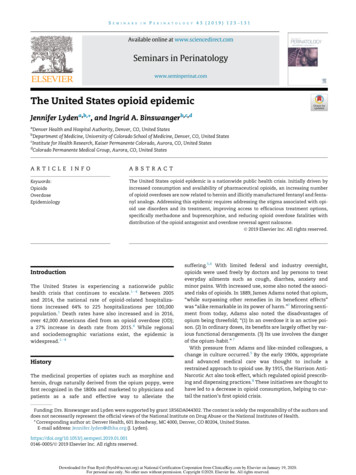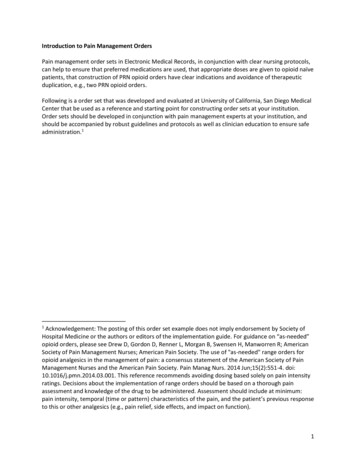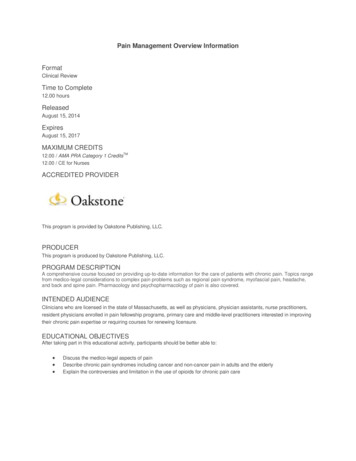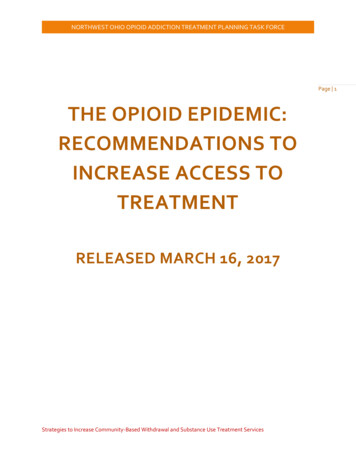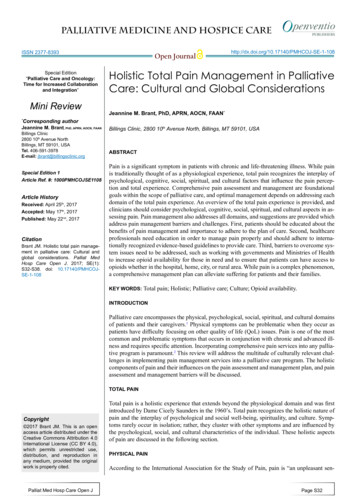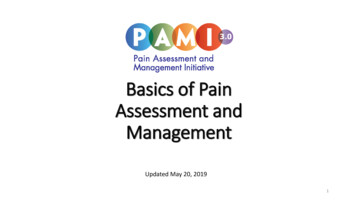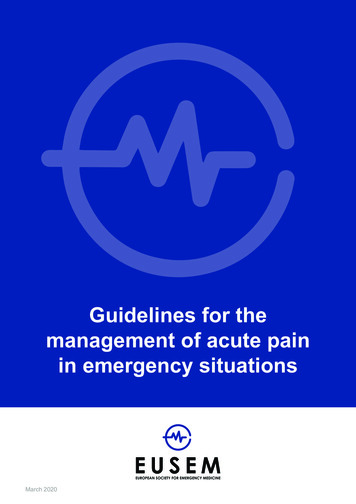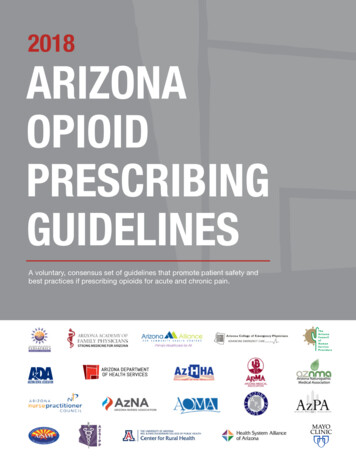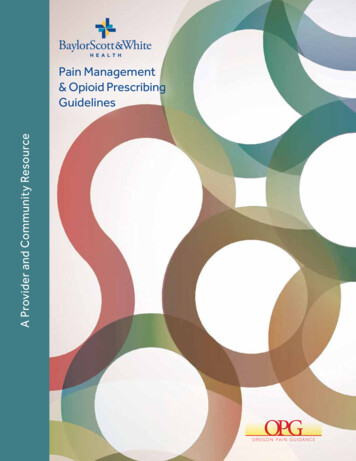
Transcription
A Provider and Community ResourcePain Management& Opioid PrescribingGuidelines
CONTENTSINTRODUCTION5Baylor Scott & White Health (BSWH) . . . . . . . . . . . . . . . . . . . . . . . . . . . . . . . . . . . . . . . . . . . . . . . . . . . . 5Oregon Pain Guidance Group (OPG) . . . . . . . . . . . . . . . . . . . . . . . . . . . . . . . . . . . . . . . . . . . . . . . . . . . . . 6Guidelines Authors and Contributors . . . . . . . . . . . . . . . . . . . . . . . . . . . . . . . . . . . . . . . . . . . . . . . . . . . 6CDC Guidelines . . . . . . . . . . . . . . . . . . . . . . . . . . . . . . . . . . . . . . . . . . . . . . . . . . . . . . . . . . . . . . . . . . . . . . 7Surgeon General . . . . . . . . . . . . . . . . . . . . . . . . . . . . . . . . . . . . . . . . . . . . . . . . . . . . . . . . . . . . . . . . . . . . . 8Axioms of Pain Treatment . . . . . . . . . . . . . . . . . . . . . . . . . . . . . . . . . . . . . . . . . . . . . . . . . . . . . . . . . . . . . 8Team Approach to Pain Management . . . . . . . . . . . . . . . . . . . . . . . . . . . . . . . . . . . . . . . . . . . . . . . . . . 10How to Use these Guidelines . . . . . . . . . . . . . . . . . . . . . . . . . . . . . . . . . . . . . . . . . . . . . . . . . . . . . . . . . . 10Morphine Equivalent Dose (MED) . . . . . . . . . . . . . . . . . . . . . . . . . . . . . . . . . . . . . . . . . . . . . . . . . . . . . . 11Risk Stratification . . . . . . . . . . . . . . . . . . . . . . . . . . . . . . . . . . . . . . . . . . . . . . . . . . . . . . . . . . . . . . . . . . . . 12TREATING ACUTE PAIN (0 –7 DAYS FOLLOWING TRAUMA OR SURGERY)14Assessment . . . . . . . . . . . . . . . . . . . . . . . . . . . . . . . . . . . . . . . . . . . . . . . . . . . . . . . . . . . . . . . . . . . . . . . . . 14Non-Opioid Treatment . . . . . . . . . . . . . . . . . . . . . . . . . . . . . . . . . . . . . . . . . . . . . . . . . . . . . . . . . . . . . . . 14Opioid Treatment . . . . . . . . . . . . . . . . . . . . . . . . . . . . . . . . . . . . . . . . . . . . . . . . . . . . . . . . . . . . . . . . . . . . 14Patient Instructions . . . . . . . . . . . . . . . . . . . . . . . . . . . . . . . . . . . . . . . . . . . . . . . . . . . . . . . . . . . . . . . . . . 15Tools . . . . . . . . . . . . . . . . . . . . . . . . . . . . . . . . . . . . . . . . . . . . . . . . . . . . . . . . . . . . . . . . . . . . . . . . . . . . . . . 15Acute Pain Flow Sheet . . . . . . . . . . . . . . . . . . . . . . . . . . . . . . . . . . . . . . . . . . . . . . . . . . . . . . . . . . . . . . . . 16TREATING CHRONIC PAIN (PAIN LASTING MORE THAN THREE MONTHS)17Categorization of Chronic Pain Patients . . . . . . . . . . . . . . . . . . . . . . . . . . . . . . . . . . . . . . . . . . . . . . . . 17Nociceptive and Neuropathic Pain . . . . . . . . . . . . . . . . . . . . . . . . . . . . . . . . . . . . . . . . . . . . . . . . . . . . . 18Centralized Pain or Central Sensitization (CS) . . . . . . . . . . . . . . . . . . . . . . . . . . . . . . . . . . . . . . . . . . . 18Assessment and Treatment of Chronic Non-Cancer Pain (CNCP) . . . . . . . . . . . . . . . . . . . . . . . . . . 19Opioid Treatment . . . . . . . . . . . . . . . . . . . . . . . . . . . . . . . . . . . . . . . . . . . . . . . . . . . . . . . . . . . . . . . . . . . . 19Non-Opioid Treatment . . . . . . . . . . . . . . . . . . . . . . . . . . . . . . . . . . . . . . . . . . . . . . . . . . . . . . . . . . . . . . . 20Patient Instructions . . . . . . . . . . . . . . . . . . . . . . . . . . . . . . . . . . . . . . . . . . . . . . . . . . . . . . . . . . . . . . . . . . 20Tapering . . . . . . . . . . . . . . . . . . . . . . . . . . . . . . . . . . . . . . . . . . . . . . . . . . . . . . . . . . . . . . . . . . . . . . . . . . . . 21Additional Concerns . . . . . . . . . . . . . . . . . . . . . . . . . . . . . . . . . . . . . . . . . . . . . . . . . . . . . . . . . . . . . . . . . 21Chronic Pain Flow Sheet . . . . . . . . . . . . . . . . . . . . . . . . . . . . . . . . . . . . . . . . . . . . . . . . . . . . . . . . . . . . . . 22NON-OPIOID OPTIONS23Treatment Comparisons . . . . . . . . . . . . . . . . . . . . . . . . . . . . . . . . . . . . . . . . . . . . . . . . . . . . . . . . . . . . . . 23Non-Opioid Treatment Options . . . . . . . . . . . . . . . . . . . . . . . . . . . . . . . . . . . . . . . . . . . . . . . . . . . . . . . 24Behavioral Treatment Options . . . . . . . . . . . . . . . . . . . . . . . . . . . . . . . . . . . . . . . . . . . . . . . . . . . . . . . . 25SPECIALTY CARE FOR TREATING CHRONIC PAINPain Specialty Care – Interventional Pain Medicine . . . . . . . . . . . . . . . . . . . . . . . . . . . . . . . . . . . . . . .Pain Specialty Care – Chemical Dependency Services . . . . . . . . . . . . . . . . . . . . . . . . . . . . . . . . . . . .Pain Specialty Care – Interdisciplinary Pain Programs . . . . . . . . . . . . . . . . . . . . . . . . . . . . . . . . . . . .“Pain Clinics” . . . . . . . . . . . . . . . . . . . . . . . . . . . . . . . . . . . . . . . . . . . . . . . . . . . . . . . . . . . . . . . . . . . . . . . .2727282930
TRAUMA-INFORMED CARE (CHILDHOOD TRAUMA, PTSD & CHRONIC PAIN)Trauma and Chronic Pain . . . . . . . . . . . . . . . . . . . . . . . . . . . . . . . . . . . . . . . . . . . . . . . . . . . . . . . . . . . . .Screening and Referral Overview . . . . . . . . . . . . . . . . . . . . . . . . . . . . . . . . . . . . . . . . . . . . . . . . . . . . . .Trauma-Informed Treatment . . . . . . . . . . . . . . . . . . . . . . . . . . . . . . . . . . . . . . . . . . . . . . . . . . . . . . . . .What Can Healthcare Providers Do . . . . . . . . . . . . . . . . . . . . . . . . . . . . . . . . . . . . . . . . . . . . . . . . . . . .Tools . . . . . . . . . . . . . . . . . . . . . . . . . . . . . . . . . . . . . . . . . . . . . . . . . . . . . . . . . . . . . . . . . . . . . . . . . . . . . . .TREATING HEADACHES31313132323233Signs and Symptoms of Secondary Headache . . . . . . . . . . . . . . . . . . . . . . . . . . . . . . . . . . . . . . . . . . . 33Primary Headaches . . . . . . . . . . . . . . . . . . . . . . . . . . . . . . . . . . . . . . . . . . . . . . . . . . . . . . . . . . . . . . . . . . 33Treatment of Primary Headaches . . . . . . . . . . . . . . . . . . . . . . . . . . . . . . . . . . . . . . . . . . . . . . . . . . . . . . 34Migraine Treatments . . . . . . . . . . . . . . . . . . . . . . . . . . . . . . . . . . . . . . . . . . . . . . . . . . . . . . . . . . . . . . . . . 34Treatment of Headache Other Than Migraine . . . . . . . . . . . . . . . . . . . . . . . . . . . . . . . . . . . . . . . . . . . 35American Headache Society . . . . . . . . . . . . . . . . . . . . . . . . . . . . . . . . . . . . . . . . . . . . . . . . . . . . . . . . . . 35TREATING PAIN IN CHILDREN AND ADOLESCENTS36General Facts . . . . . . . . . . . . . . . . . . . . . . . . . . . . . . . . . . . . . . . . . . . . . . . . . . . . . . . . . . . . . . . . . . . . . . . 36Assessment . . . . . . . . . . . . . . . . . . . . . . . . . . . . . . . . . . . . . . . . . . . . . . . . . . . . . . . . . . . . . . . . . . . . . . . . . 37Treatment . . . . . . . . . . . . . . . . . . . . . . . . . . . . . . . . . . . . . . . . . . . . . . . . . . . . . . . . . . . . . . . . . . . . . . . . . . 37Tools . . . . . . . . . . . . . . . . . . . . . . . . . . . . . . . . . . . . . . . . . . . . . . . . . . . . . . . . . . . . . . . . . . . . . . . . . . . . . . . 38PAIN CONTROL IN THE ELDERLY AND INDIVIDUALS WITH DEMENTIA39Chronic Pain in the Elderly Population . . . . . . . . . . . . . . . . . . . . . . . . . . . . . . . . . . . . . . . . . . . . . . . . . . 39Evaluation of the Elderly Patient . . . . . . . . . . . . . . . . . . . . . . . . . . . . . . . . . . . . . . . . . . . . . . . . . . . . . . . 39Goals of Treatment . . . . . . . . . . . . . . . . . . . . . . . . . . . . . . . . . . . . . . . . . . . . . . . . . . . . . . . . . . . . . . . . . . 39Non-Pharmaceutical Approach . . . . . . . . . . . . . . . . . . . . . . . . . . . . . . . . . . . . . . . . . . . . . . . . . . . . . . . . 40Pharmaceutical Approach . . . . . . . . . . . . . . . . . . . . . . . . . . . . . . . . . . . . . . . . . . . . . . . . . . . . . . . . . . . . 40Pain Treatment in Patients with Dementia . . . . . . . . . . . . . . . . . . . . . . . . . . . . . . . . . . . . . . . . . . . . . . 42OPIOID USE DURING PREGNANCY44TAPERING45Opioid Taper/Discontinuation . . . . . . . . . . . . . . . . . . . . . . . . . . . . . . . . . . . . . . . . . . . . . . . . . . . . . . . . . 45Opioid Tapering Flow Sheet . . . . . . . . . . . . . . . . . . . . . . . . . . . . . . . . . . . . . . . . . . . . . . . . . . . . . . . . . . . 48Benzodiazepine Taper/Discontinuation . . . . . . . . . . . . . . . . . . . . . . . . . . . . . . . . . . . . . . . . . . . . . . . . . 49Benzodiazepine Tapering Flow Sheet . . . . . . . . . . . . . . . . . . . . . . . . . . . . . . . . . . . . . . . . . . . . . . . . . . . 52OTHER CONSIDERATIONS53Texas Prescription Monitoring Program (PMP) . . . . . . . . . . . . . . . . . . . . . . . . . . . . . . . . . . . . . . . . . . . 53Concomitant Benzodiazepine and Opioid Use . . . . . . . . . . . . . . . . . . . . . . . . . . . . . . . . . . . . . . . . . . . 53Concomitant Marijuana and Opioid Use . . . . . . . . . . . . . . . . . . . . . . . . . . . . . . . . . . . . . . . . . . . . . . . . 53Disposal . . . . . . . . . . . . . . . . . . . . . . . . . . . . . . . . . . . . . . . . . . . . . . . . . . . . . . . . . . . . . . . . . . . . . . . . . . . . 53Medication-Assisted Treatment (MAT) . . . . . . . . . . . . . . . . . . . . . . . . . . . . . . . . . . . . . . . . . . . . . . . . . 54Heroin . . . . . . . . . . . . . . . . . . . . . . . . . . . . . . . . . . . . . . . . . . . . . . . . . . . . . . . . . . . . . . . . . . . . . . . . . . . . . . 54Naloxone . . . . . . . . . . . . . . . . . . . . . . . . . . . . . . . . . . . . . . . . . . . . . . . . . . . . . . . . . . . . . . . . . . . . . . . . . . . 55
MEDICATIONS THAT WARRANT SPECIAL ATTENTION57Sleeping Pills (Z Drugs and Others) . . . . . . . . . . . . . . . . . . . . . . . . . . . . . . . . . . . . . . . . . . . . . . . . . . . . 57Tramadol and Tapentadol . . . . . . . . . . . . . . . . . . . . . . . . . . . . . . . . . . . . . . . . . . . . . . . . . . . . . . . . . . . . . 57Carisoprodol . . . . . . . . . . . . . . . . . . . . . . . . . . . . . . . . . . . . . . . . . . . . . . . . . . . . . . . . . . . . . . . . . . . . . . . . 58Meperidine . . . . . . . . . . . . . . . . . . . . . . . . . . . . . . . . . . . . . . . . . . . . . . . . . . . . . . . . . . . . . . . . . . . . . . . . . . 58Long-Acting Opioids . . . . . . . . . . . . . . . . . . . . . . . . . . . . . . . . . . . . . . . . . . . . . . . . . . . . . . . . . . . . . . . . . 58Methadone . . . . . . . . . . . . . . . . . . . . . . . . . . . . . . . . . . . . . . . . . . . . . . . . . . . . . . . . . . . . . . . . . . . . . . . . . 58Gabapentin . . . . . . . . . . . . . . . . . . . . . . . . . . . . . . . . . . . . . . . . . . . . . . . . . . . . . . . . . . . . . . . . . . . . . . . . . 59THE ART OF DIFFICULT CONVERSATIONS60Value Identification . . . . . . . . . . . . . . . . . . . . . . . . . . . . . . . . . . . . . . . . . . . . . . . . . . . . . . . . . . . . . . . . . . 60Realistic Expectations . . . . . . . . . . . . . . . . . . . . . . . . . . . . . . . . . . . . . . . . . . . . . . . . . . . . . . . . . . . . . . . . 61Willingness to Feel Uncomfortable . . . . . . . . . . . . . . . . . . . . . . . . . . . . . . . . . . . . . . . . . . . . . . . . . . . . . 61Relationship as a Resource . . . . . . . . . . . . . . . . . . . . . . . . . . . . . . . . . . . . . . . . . . . . . . . . . . . . . . . . . . . . 61Belief and Confidence . . . . . . . . . . . . . . . . . . . . . . . . . . . . . . . . . . . . . . . . . . . . . . . . . . . . . . . . . . . . . . . . 61Resources . . . . . . . . . . . . . . . . . . . . . . . . . . . . . . . . . . . . . . . . . . . . . . . . . . . . . . . . . . . . . . . . . . . . . . . . . . 61TOOLS62Assessment Tools . . . . . . . . . . . . . . . . . . . . . . . . . . . . . . . . . . . . . . . . . . . . . . . . . . . . . . . . . . . . . . . . . . . 62Laboratory Screening . . . . . . . . . . . . . . . . . . . . . . . . . . . . . . . . . . . . . . . . . . . . . . . . . . . . . . . . . . . . . . . . 63Patient-Provider Communication . . . . . . . . . . . . . . . . . . . . . . . . . . . . . . . . . . . . . . . . . . . . . . . . . . . . . . 64Assessing Progress . . . . . . . . . . . . . . . . . . . . . . . . . . . . . . . . . . . . . . . . . . . . . . . . . . . . . . . . . . . . . . . . . . 64Other Tools . . . . . . . . . . . . . . . . . . . . . . . . . . . . . . . . . . . . . . . . . . . . . . . . . . . . . . . . . . . . . . . . . . . . . . . . . 64REFERENCES66APPENDICES68ABCDEFGHIJKLMNORT: Opioid Risk Tool . . . . . . . . . . . . . . . . . . . . . . . . . . . . . . . . . . . . . . . . . . . . . . . . . . . . . . . . . . . . . . . . . 68SOAPP -R: Screen and Opioid Assessment for Patients with Pain . . . . . . . . . . . . . . . . . . . . . . . . . 69Primary Care PTSD Screen . . . . . . . . . . . . . . . . . . . . . . . . . . . . . . . . . . . . . . . . . . . . . . . . . . . . . . . . . . . . .71S T O P B A N G: Screening for Obstructive Sleep Apnea . . . . . . . . . . . . . . . . . . . . . . . . . . . . . . . . . .73Chronic Pain Treatment Checklist . . . . . . . . . . . . . . . . . . . . . . . . . . . . . . . . . . . . . . . . . . . . . . . . . . . . . . . 74Urine Drug Screenings (UDS) FAQ . . . . . . . . . . . . . . . . . . . . . . . . . . . . . . . . . . . . . . . . . . . . . . . . . . . . . . 75Metabolism Data for Common Medications . . . . . . . . . . . . . . . . . . . . . . . . . . . . . . . . . . . . . . . . . . . . . .78Controlled Substance Consent and Agreement for Chronic Pain . . . . . . . . . . . . . . . . . . . . . . . . . . 80Medical Risks of Long-Term Opioid Use . . . . . . . . . . . . . . . . . . . . . . . . . . . . . . . . . . . . . . . . . . . . . . . . . 82Graded Pain and Function Scale . . . . . . . . . . . . . . . . . . . . . . . . . . . . . . . . . . . . . . . . . . . . . . . . . . . . . . . . 83Oswestry Low Back Pain Disability Questionnaire . . . . . . . . . . . . . . . . . . . . . . . . . . . . . . . . . . . . . . . 84PEG-3: Pain Screening Tool . . . . . . . . . . . . . . . . . . . . . . . . . . . . . . . . . . . . . . . . . . . . . . . . . . . . . . . . . . . . 86Additional Assessment Tools . . . . . . . . . . . . . . . . . . . . . . . . . . . . . . . . . . . . . . . . . . . . . . . . . . . . . . . . . . .87Behavioral Health Risks Screening Tool for Pregnant Womenand Women of Childbearing Age . . . . . . . . . . . . . . . . . . . . . . . . . . . . . . . . . . . . . . . . . . . . . . . . . . . . . . . 88O Opioid Withdrawal Attenuation Cocktail . . . . . . . . . . . . . . . . . . . . . . . . . . . . . . . . . . . . . . . . . . . . . . . . 89P Texas Medical Board – Chronic Pain . . . . . . . . . . . . . . . . . . . . . . . . . . . . . . . . . . . . . . . . . . . . . . . . . . . . . 90
For the past few decades, a conceptual shift has taken place regarding the treatment of chronic pain. Opioidshave been encouraged for the treatment of all types of pain. In particular, chronic non-cancer pain wassuggested as a treatable condition necessitating long-acting medications, without solid scientific evidencesupporting that practice. As a society, we are reaping the consequences of that change in prescribing habits withan increase in opioid dependency, accidental drug overdoses, and heroin use. The expectation on the part of thepublic that there is a pill to be prescribed for any discomfort is harder to quantify but no less important.1,2,3INTRODUCTIONINTRODUCTIONThe community consequences of excessive opioid prescribing are manifest. In addition to the mortality andquality-of-life consequences previously mentioned, we are facing an increase in communicable diseasesassociated with substance-use disorders (HIV, hepatitis, syphilis), strains on the court system and treatmentprograms, and a “lost generation” of patients dependent upon opioids who are a challenge to treat humanelyand effectively.The message embodied in this document is that opioids are powerful drugs that can create calm and reliefwhen used wisely but can cause great harm when prescribed injudiciously. Every encounter with a patient inpain will require the same analysis, and patient safety should guide all treatment recommendations.› What is the etiology of the pain, and would non-opioid treatment suffice?› Are there risk factors present that would make the use of opioids unsafe for this patient?› What is the usual expectation for pain for this condition? Is my patient’s response outside that expectedrange?› Is there a medical justification for this dose of opioid, for this length of time, for this condition, in thispatient?Practicing outside those parameters may put your patient, or your patient’s family, or the community at large,at risk. Too many pills prescribed for a given situation may create dependency in your patient, or if they arestolen or diverted, can feed the illicit habit of others.This is an iatrogenic public health crisis, and all of us in the healthcare profession have to assumeresponsibility in fixing it.4Baylor Scott & White Health (BSWH) The information contained in this document should not be considered standards of professional practice or rulesof conduct or for the benefit of any third party. This document is intended to provide guidance and, generally,allows for professional discretion and/or deviation when the individual health care provider deems appropriateunder the circumstances.Adapted from Oregon Pain Guidance (OPG)www oregonpainguidance orgINTRODUCTIONClinical Leadership at Baylor Scott & White Health is committed to educating our medical providers on thelatest evidence regarding chronic pain physiology and therapy. These guidelines are provided as a resourcefor our physicians and other caregivers as they strive to treat our patients who have pain. In addition to theseguidelines, which provide overall information about pain treatment, we have produced an educational videothat offers continuing medical education credit for our providers. All of us need to understand the sciencethat underlies current best-practice recommendations for treatment of pain, and to be able to communicatethese to patients. Our hope is that all our providers will share common understanding, our patients will heara consistent message, and the community at large will support these efforts.5
INTRODUCTIONInstitutional support for this project came from the Clinical Leadership Council, chaired by Robert Probe,MD, and the Central Texas Board of Directors, chaired by Alejandro Arroliga, MD. The Executive Sponsorwas Glen Couchman, MD. Other leaders providing support for this project included Steven Sibbitt, MD, andTimothy Bittenbinder, MD. Tiffany Berry, MD, and Michael Massey, MD, along with Mae Centeno, DPN,provided assistance with overall institutional support and infrastructure for the project. Co-chairs JudyEmbry, PhD, and Michael Reis, MD, provided leadership for a taskforce of expert practicing clinicians fromthe Baylor Scott & White Health system, which adapted these guidelines for use in the Baylor Scott & WhiteHealth system and produced a corresponding CME video. Members of that group included James Albers,MD; Chris Burnett, MD; Timothy Clark, PhD; Radha Kambhampati, MD; Glen Ledbetter, MD; Jason Sapp,DO, with Layne Stone as the project manager. This group developed the video content and, along with EmilyGarmon, MD; Rodney Lange, MD; and Amber Whittenburg, MD, participated in the video, with CinamonRomers, PhD, and Jae Ross, PsyD, as actors.Oregon Pain Guidance Group (OPG) The Guidelines on which the Baylor Scott & White Health guidelines are based, were authored by OregonPain Guidance (OPG), a group of physicians, nurse practitioners, physician assistants, nurses, pharmacists,medical directors, insurance providers, emergency room providers, pain medicine specialists, mental healthcounselors, substance abuse professionals, public health professionals, and others in Southern Oregon. TheOPG group—and in particular the steering committee—promotes community education, an annual painconference, the OPG website, and the original production of these guidelines.Guidelines Authors and Contributors With the release of the CDC guidelines,5 OPG focused their attention on operationalizing these nationallyrecognized best practices to provide real-world tools and advice to practicing clinicians as they seek to complywith this excellent national guidance document. The OPG guidelines have been influenced by the work ofthe Washington State Medical Directors Group,6 the CDC, and many other leaders in the state of Oregonand nationally in the field of safe opioid prescribing. The majority of the drafting and revisions were doneby three individuals: Jim Shames, MD, Medical Director and Health Officer of Jackson County Health andHuman Services; John Kolsbun, MD, Medical Director of AllCare Health, and Mark Stephens, a healthcareconsultant. Other significant contributors were Laura Heesacker, LCSW; Sara Smith, RN; Rachel Vossen,PharmD; Mark Kantor, RPh; and Paul Coelho, MD; as well as other members of the OPG group who addedadditional content.These Baylor Scott & White Health guidelines are an adaptation of guidelines written by OPG. The BSWHtaskforce, described above, added to the content of the OPG guidelines and adapted them for use in Texasand BSWH. In addition to this group, other Baylor Scott & White Health contributors included Aval-Na’ReeGreen, MD; Tran Cassandra Huynh, MD; Javier Kane, MD; and Michael Ready, MD. We are grateful forall contributors to this effort. These guidelines are for all who work with patients with pain, includingprescribers, behavioral health professionals, physical and occupational therapists, nurses, those who dispensepain medications, and those who pay for these services.6Pain Management and Opioid Prescribing Guidelines – Baylor Scott & White HealthMarch 2017
In March 2016, the CDC issued new guidelines on opioid prescribing.5 The importance of these guidelinescannot be overstated as they establish national recommendations for the use of opioids for treatmentof chronic pain. We support and endorse these new guidelines. This is a summary of the 12 CDCrecommendations.Determining when to initiate or continue opioids for chronic pain1. Non-pharmacologic therapy and non-opioid pharmacologic therapy are preferred for chronic pain.Clinicians should consider opioid therapy only if expected benefits for both pain and function areanticipated to outweigh risks to the patient. If opioids are used, they should be combined with nonpharmacologic therapy and non-opioid pharmacologic therapy, as appropriate.INTRODUCTIONCDC Guidelines 2. Before starting opioid therapy for chronic pain, clinicians should establish treatment goals with allpatients, including realistic goals for pain and function, and should consider how therapy will bediscontinued if benefits do not outweigh risks. Clinicians should continue opioid therapy only if there isclinically meaningful improvement in pain and function that outweighs risks to patient safety.3. Before starting and periodically during opioid therapy, clinicians should discuss with patients known risksand realistic benefits of opioid therapy and patient and clinician responsibilities for managing therapy.Opioid selection, dosage, duration, follow-up, and discontinuation4. When starting opioid therapy for chronic pain, clinicians should prescribe immediate-release opioidsinstead of extended-release/long-acting (ER/LA) opioids.5. When opioids are started, clinicians should prescribe the lowest effective dosage. Clinicians should usecaution when prescribing opioids at any dosage, should carefully reassess evidence of individual benefitsand risks when increasing dosage to 50 morphine milligram equivalents (MED) per day, and shouldavoid increasing dosage to 90 MED/day or carefully justify a decision to titrate dosage to 90
14 Pain Management and Opioid Prescribing Guidelines - Baylor Scott & White Health March 2017 TREATING ACUTE PAIN (0-7 Days Following Trauma or Surgery) In most cases, acute pain can be treated e Ëectively with non-opioid or non-pharmacological options (e g rest, elevation, ice) With more severe acute injury (e g ,
